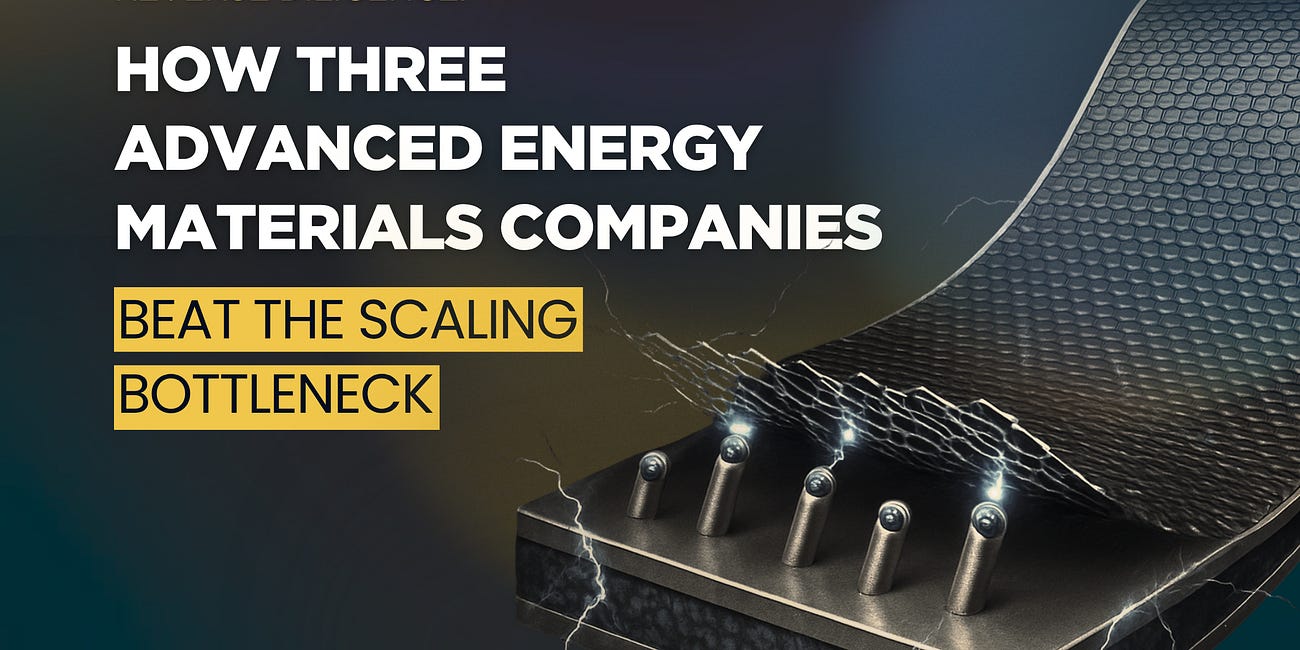Welcome to the 81st edition of Deep Tech Catalyst, the channel by The Scenarionist, where science meets venture!
If you’re building in energy, climate, or industrial deep tech—and want to understand how to bridge the toughest funding gaps—this episode is for you.
Today, we sit down with Michel de Lempdes, Managing Partner at Omnes Capital!
From next-generation micro nuclear reactors to carbon removal startups, the race to decarbonize industries is pushing founders to navigate complex capital needs, market validation, and scale-up challenges.
In this conversation, Michel shares what investors really look for in a Deep Tech company’s path from Series A to Series B, how to stage financing to avoid being stranded mid-project, and why debt—often overlooked—can be a smart strategic lever for hardware-heavy ventures.
In this edition, we explore:
Why proven technology beats hype every time
How real-world validation goes beyond soft signals
What seasoned investors look for in founding teams
How to avoid the “middle of nowhere” trap when raising capital
Smart ways to balance equity, debt, and public funding
Let’s dive in. ⚡️
✨ For more, see Membership | Deep Tech Briefing | Insights | VC Guides
BEYOND THE CONVERSATION — REFLECTIONS & STRATEGIC INSIGHTS FROM THE EPISODE
Proven Technology Before Anything Else
One of the strongest takeaways from this conversation is just how crucial it is to remove raw technology risk as early as possible, especially in energy and industrial Deep Tech.
Michel was clear: when his team backs a company at the Series A stage, they expect to see a technology that’s been meaningfully validated. It’s the baseline for attracting capital.
That validation doesn’t necessarily come in the form of revenue, and for capital-intensive hardware like a next-generation microreactor, it rarely does at first. Instead, what matters is whether the core technology has been de-risked in ways that hold up under real-world conditions.
For founders, this means doing the hard work upfront: proving that the science works, confirming that the design meets the standards of potential customers or partners, and building the relationships that show real interest.
Investors will run their own reference calls, speak directly with potential customers, and tap technical experts from their networks. The goal is to see evidence that the technology solves a problem in a way that industry players trust.
This goes far beyond collecting simple letters of intent for the pitch deck.
True validation shows up as concrete commitments: an industrial partner co-developing the product, a prototype built to realistic specs, or a strategic partner ready to walk alongside the team toward scale. These are the signals that separate hopeful ideas from investable opportunities.
Building Teams That Don’t Need Investors (Too Much)
Another theme that stood out is just how much Michel values teams that already know how to get to the next stage. Investors can help with strategy, introductions, and capital—but they aren’t there to rebuild an organization from scratch.
In the guest’s view, the reality is more pragmatic. He wants to work with entrepreneurs who, basically, don’t need him for day-to-day survival. They know their industry inside out. They understand what the missing pieces are. They’re realistic about what they still need to add—whether that’s a commercial lead, a regulatory expert, or an operational manager—and they move quickly to fill those gaps.
The First Core Team
This doesn’t mean a founding team must be perfect on day one. In Deep Tech, it rarely is. There might be an exceptional CTO, but no one is in charge of scaling sales. There might be a visionary CEO, but no operations leader yet. What matters is that there’s a strong nucleus—a “herd” that can hold the vision together. The right founding team signals that a company is more than just an idea on paper; it’s a credible company ready to grow.
Deep Tech Monthly in Review – June 2025
Field Notes from The Scenarionist. A Strategic Recap for Builders and Backers.
Milestones as a Blueprint for Raising the Next Round
In capital-intensive industries like energy hardware, the wrong sequencing can sink even the most promising venture.
One mistake Michel sees too often is founders launching major projects without securing the total financing for that phase. Once you’re halfway down the road, it’s far harder to convince new investors to close the gap.
How to Avoid the “Middle of Nowhere” Trap
The solution is almost deceptively simple: break the journey into clear, achievable milestones, and raise enough capital for each step before you commit to the next.
This approach is about discipline as much as it is about money. Here’s why:
It keeps a founding team honest about what they’re really ready to prove.
It gives investors the confidence that each round of funding is tied to measurable progress.
It prevents the nightmare scenario where a company gets stranded between big promises and partial execution.
The Case of Nuclear Microreactors: Real-World KPIs for Capital-Intensive Hardware
This isn’t theory. Take the example of nuclear microreactors—a field where real-world milestones are everything. Before you ever talk about mass production, you need your design locked down.
That means getting it approved by the relevant authorities, which can be an entire workstream on its own.
Then there’s securing critical components, lining up suppliers, acquiring land, arranging permits—every step adds credibility, de-risks the next phase, and brings new investors to the table with something concrete to evaluate.
Smart Capital Structure: Blending Equity, Debt, and Public Funding
Funding hardware at scale means balancing multiple capital sources. While it’s tempting to think equity alone will carry you to the finish line, Michel’s perspective was clear: the smartest founders start thinking about debt and non-dilutive funding early, not late.
Practical Steps for Financing and Scaling
One of the more pragmatic lessons was about the discipline required when financing hardware-heavy deep tech ventures.
Too many founders underestimate how unforgiving it is to run out of capital halfway through a major build. Once you’re stuck with a half-finished system—be it a microreactor, a pilot plant, or a critical piece of industrial equipment—finding follow-on funding becomes exponentially harder.
Michel’s perspective is clear: never launch a project phase without having secured the full financing needed to get you to the next meaningful milestone.
It’s a simple idea, but it forces founders to break big ambitions into clear, staged commitments. Each funding round should be tied to proof points that actually unlock the next step.
Take the example of a new-generation nuclear microreactor.
No credible investor will fund an entire production line before the basic design is complete and approved by the relevant authorities. The real milestone isn’t the idea of a reactor—it’s the green light that the design meets regulatory standards.
That single approval unlocks the next conversation: funding the prototype.
And with a working prototype, you earn the right to raise the capital needed for mass production.
This staged approach does more than just manage risk. It gives founders leverage.
Each phase of validation builds the company’s credibility, widens the pool of potential funders, and keeps control of dilution and debt terms on the founder’s side of the table.
Navigating Debt in Deep Tech
One point that stood out in our conversation is how overlooked debt still is in Deep Tech. Equity raises and public grants get most of the headlines, but smart founders know how to balance the stack.
Debt works best when it’s used proactively, not when you’re weeks away from emptying the bank account.
Lenders, after all, want to see a healthy cash position. That’s when they’re more willing to issue loans on favorable terms, sometimes secured by the company’s intellectual property.
For larger amounts, lenders may ask for warrants, giving them a future equity stake if the company succeeds. This hybrid structure can be a smart way to stretch your runway while limiting immediate dilution for the founding team.
Core Insight: leverage the equity you’ve raised to unlock non-dilutive capital, don’t treat debt as a last-ditch fallback when cash is tight.
When used early and responsibly, debt can help a hardware startup bridge the long, capital-intensive gap between technical milestones. It keeps the company moving from design approval to prototype to production in a way that aligns investor confidence with operational progress, without putting the entire venture at risk if markets tighten or timelines slip.
Preparing for Series B and Beyond
Michel and his team spend considerable effort identifying exactly which milestones a company must reach to attract strong Series B interest.
Before they invest, they align with the founding team on these goals—whether they’re technical, regulatory, commercial, or organizational. And they stay focused. Too many metrics create confusion; 5 or so clear KPIs, tracked rigorously, are usually enough to show a company is on track.
Beyond capital, investors play a critical role as connectors.
A portfolio company may need to build relationships with Series B investors long before they actually open a round. By keeping future funders warm, sharing progress updates, and making introductions at the right time, seasoned investors help founders step into their next raise from a position of strength.
Reverse Diligence: How Three Advanced Energy Materials Companies Beat the Scaling Bottleneck
Amprius, Nexeon & Enovix: A reverse DD analysis of three real-world scale-ups on moats, capital discipline, and scaling advanced materials for next-generation high-energy-density electronics.
A Warm Welcome to Our New Subscribers!
We’re thrilled to have you with us and want to help you get started on our platform and discover what you can explore each week.
Beyond the educational core of Deep Tech Catalyst—our video podcast series on Deep Tech venture building—we’ve built a full-fledged intelligence hub for the deep tech market.
Deep Tech Briefing: Every Sunday, we publish an in-depth briefing packed with the week’s top news, critical analysis, emerging trends in Deep Tech, and deep dives into the geopolitical shifts and regulatory updates shaping the industry.
Capital Movements: Every Monday, we offer you a fresh roundup of the most notable deals—from hot startups to newly launched funds—so you always know where the money is flowing in Deep Tech.
VC Guides: In our VC Guides collection, you find unique perspectives and insights from leading investors and experts to bring you the most actionable angles of Deep Tech investing.
Insights: We’re always experimenting with fresh content formats, such as our new column Rumors, where we highlight emerging micro-trends in specific industrial sectors—definitely not to be missed!













